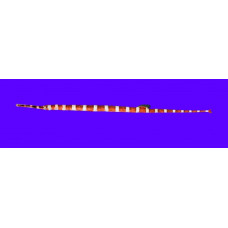Latin name
Dunckerocampus dactyliophorus
Other name
Ringed pipefish
Identification
The banded pipefish has a straight, elongated body. Fleshy veins extend from the head. These are thought to camouflage the fish when hiding in reeds.
Features of fish fins
Dorsal spines (total): 0; Dorsal soft rays (total): 20 - 26; Anal spines: 0; Anal soft rays: 4.
Fish colouring
Banded pipefish usually have a single dark band across the operculum.
Distribution
Widespread in the tropical waters of the Indo-Pacific region, including the Red Sea. Its range includes Australia, Fiji, French Polynesia, Indonesia, Japan, Marshall Islands, New Caledonia, Northern Mariana Islands, Papua New Guinea, Philippines, Samoa, Solomon Islands, South Africa and Taiwan.
Habitat
Tropical marine species. Occupies tidal pools, lagoons and the outer slopes of reefs in tropical climates. Depths from 5 to 56 metres.
Size
These fish reach a maximum length of 19 centimetres.
Behavior
Found alone, in pairs or small groups in caves or crevices.
Food and feeding habits
Banded pipefish feed on small invertebrates.
Reproduction
Like other pipefishes, the male is equipped with a special brood pouch, unlike the female. The female lays eggs in the male's pouch, where they develop. Later the male gives birth. Can breed in captivity.
Fishing
It is a commercial species of fish and can be found in aquarium shops.
Relationship with a person
Harmless.
| Classification | |
| Phylum | Chordata |
| Class | Actinopterygii |
| Squad | Syngnathiformes |
| Family | Syngnathidae |
| Genus | Dunckerocampus |
| Species | D. dactyliophorus |
| Features | |
| Conservation status | Data Deficient |
| Habitat | Pelagic |
| Life span, years | No information |
| Maximum body weight, kg | No information |
| Maximum length, cm | 19 |
| Sailing speed, m/s | No information |
| Threat to people | Not edible |
| Way of eating | Planktonophage |
Banded pipefish
Tags: banded pipefish


